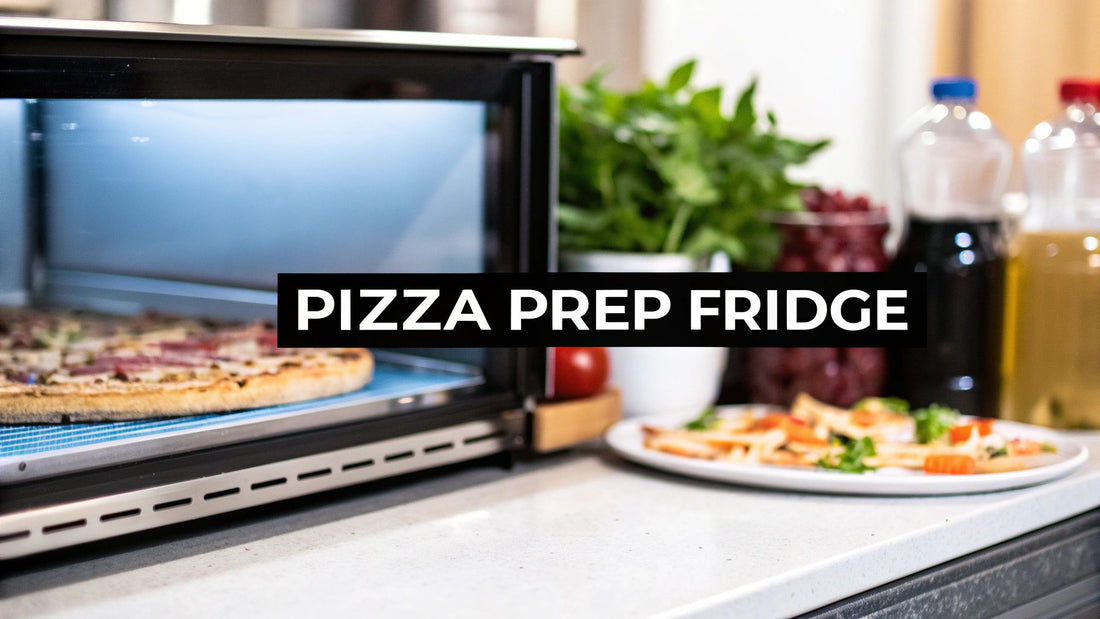
Under Counter Refrigerator Dimensions for Pizza Restaurants
Share
Picking the right under counter refrigerator for your pizza restaurant is about more than just making sure it fits—it's about engineering a smarter, faster pizza prep line. The real magic isn't in the standard width or depth; it's in understanding how under counter refrigerator dimensions directly shape your team's workflow, from grabbing toppings to keeping ingredients ice-cold during a chaotic dinner rush.
Choosing the Right Refrigerator for Your Pizza Prep Table
A well-chosen under counter unit is the heart of your pizza prep station, turning what could be a cramped corner into a hub of streamlined production. For any high-volume pizzeria, this isn't just an equipment choice. It's a strategic business decision that works as hard as you do, transforming a simple measurement task into a serious investment in efficiency.
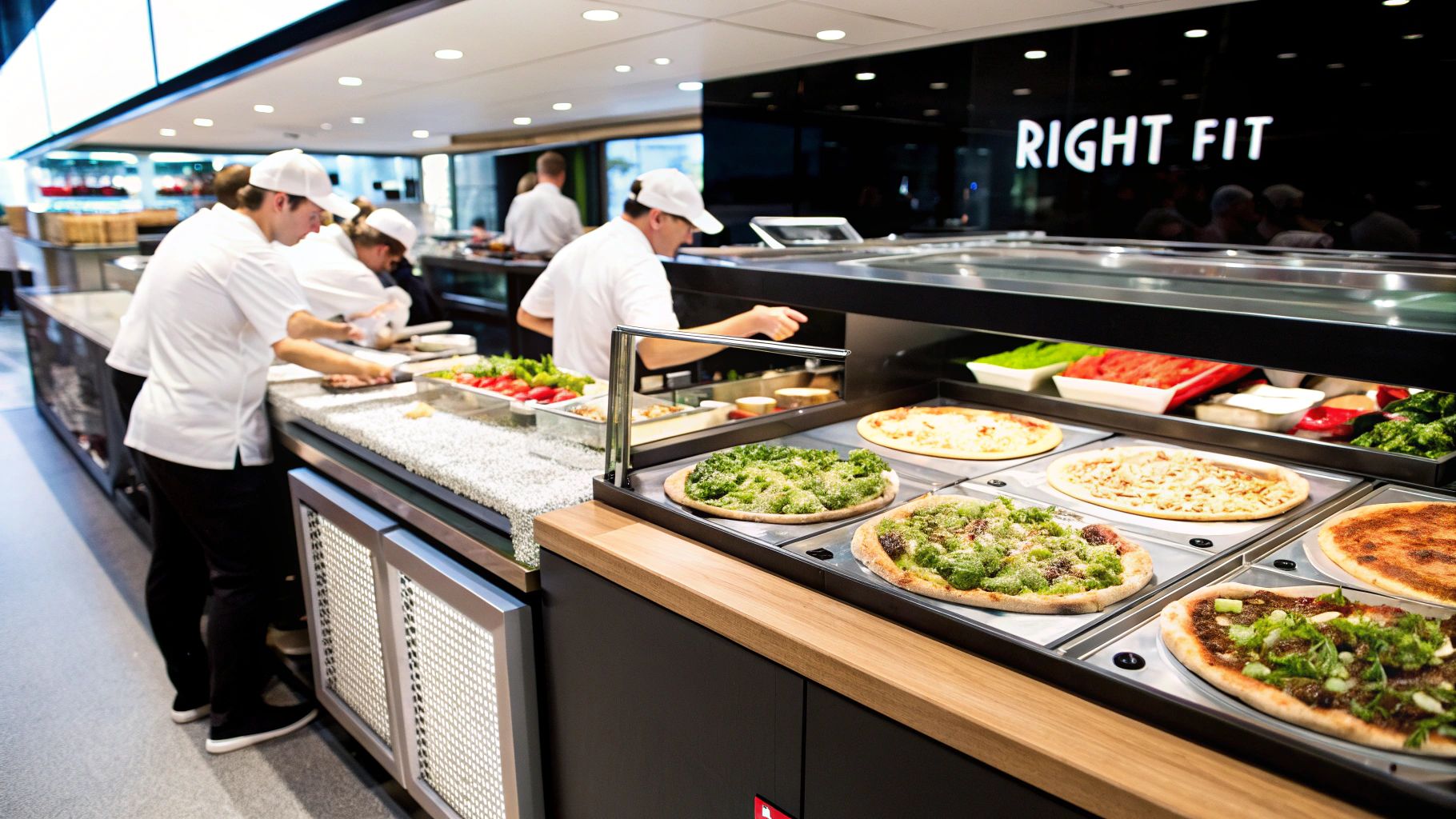
This guide will cut through the noise and focus on what actually matters for your pizzeria. Think of your prep line like an assembly line. Every extra step, every awkward reach costs you precious seconds that add up fast during a busy service. The right dimensions ensure everything your pizza makers need is right there, within arm's length.
Matching Dimensions to Your Workflow
The goal here is simple: create an ergonomic and efficient pizza-making environment. The dimensions of your refrigerator are what dictate how smoothly your team can actually operate.
- Width: This directly impacts how many ingredient pans you can keep at the ready. A wider unit might even let two pizza makers work side-by-side without constantly bumping elbows.
- Depth: This is all about aisle clearance. A unit that's too deep can create a serious bottleneck in a tight kitchen, getting in the way and creating safety hazards.
- Height: This determines the working surface height of the prep table above it. Get this wrong, and you're setting your staff up for fatigue and discomfort over long, grueling shifts.
For a major project like a complete kitchen overhaul or building out a new space, insights from a project like remodeling an office into a restaurant can offer a ton of perspective on space planning and how equipment fits into the bigger picture. And while most pizzerias default to solid doors, you might find that an under-counter glass door refrigerator gives you better visibility, letting staff find ingredients at a glance without letting all the cold air out.
Ultimately, the perfect under counter refrigerator dimensions are less about hitting some industry standard and more about finding what truly supports your specific menu and pizza prep line layout.
Understanding Standard Refrigerator Dimensions for Pizza Prep Tables
When you're staring at a spec sheet, those numbers can feel pretty abstract. But translating them into how your pizzeria actually runs is what separates a good setup from a great one. Under counter refrigerator dimensions aren't just about fitting a box into a space; they dictate how your pizza makers move and work during a hectic dinner rush.
Think of it this way: a standard 48-inch model is like a self-contained workstation for one pizza maker. It's the perfect fit for a streamlined menu where your most popular toppings—mozzarella, pepperoni, mushrooms—are always just an arm's length away. This size keeps one employee moving efficiently without hogging valuable floor space.
Now, picture a bigger 72-inch unit. This isn't just a workstation; it's a central command hub for a high-volume pizza line. It’s built for the pizzeria with a sprawling menu—artichoke hearts, multiple cheeses, all kinds of cured meats. A unit this size can easily support several staff members working side-by-side, making it a must-have for busy kitchens.
The goal is to see past the measurements and visualize how each size fits into your team's real-world pizza-making workflow. You're not just buying a fridge; you're choosing a tool that's meant to make your pizzeria faster, more organized, and less chaotic.
How Dimensions Impact Your Pizza Prep Line
While width gets all the attention, it’s only one part of the story. The unit's depth can either create a smooth traffic flow or a frustrating bottleneck in a tight kitchen. And height? That directly affects the ergonomics of the pizza prep surface on top, which can make a huge difference in your staff's comfort and speed over a long shift.
This infographic really nails down the decision-making process.
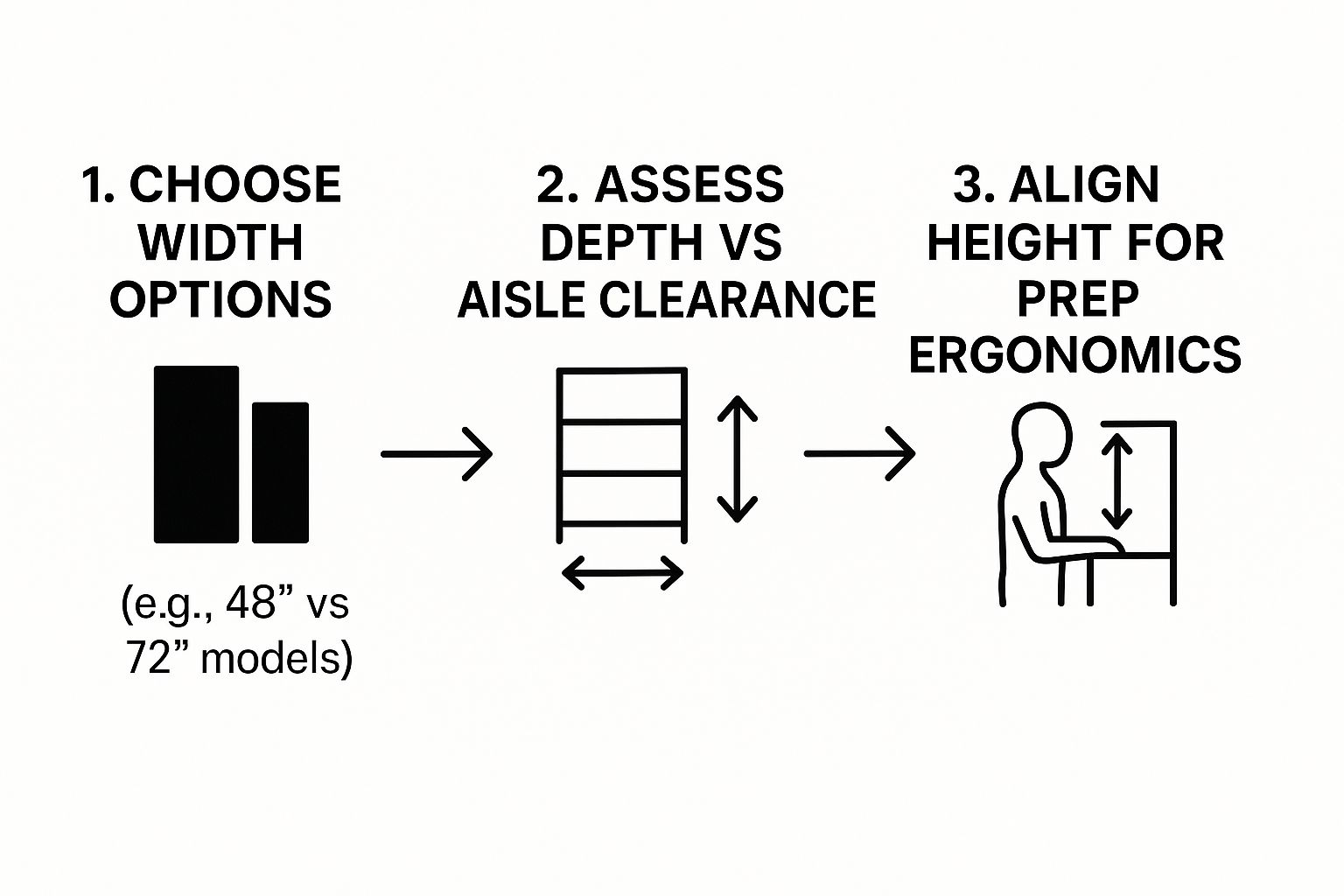
As you can see, it’s a logical path. You start by matching the width to your menu's complexity, then balance the depth against your kitchen's layout, and finally, you dial in the height for a comfortable workspace.
As commercial kitchens have gotten smarter about using every square inch, manufacturers have responded by standardizing their product sizes. This growth in the undercounter refrigerator market means you'll find more options designed to slide perfectly under pizza prep tables. To get a better feel for how these units fit into common kitchen layouts, it’s worth checking out a guide on typical cabinet sizes.
How to Accurately Measure Your Pizzeria Space
Think of sliding a new under-counter prep fridge into your pizza line like fitting the last, crucial piece into a complex puzzle—it has to be perfect. Just measuring the basic width, height, and depth isn’t enough. You need to think like an installer to make sure your new unit becomes a seamless part of your pizza-making workflow, not a frustrating obstacle.
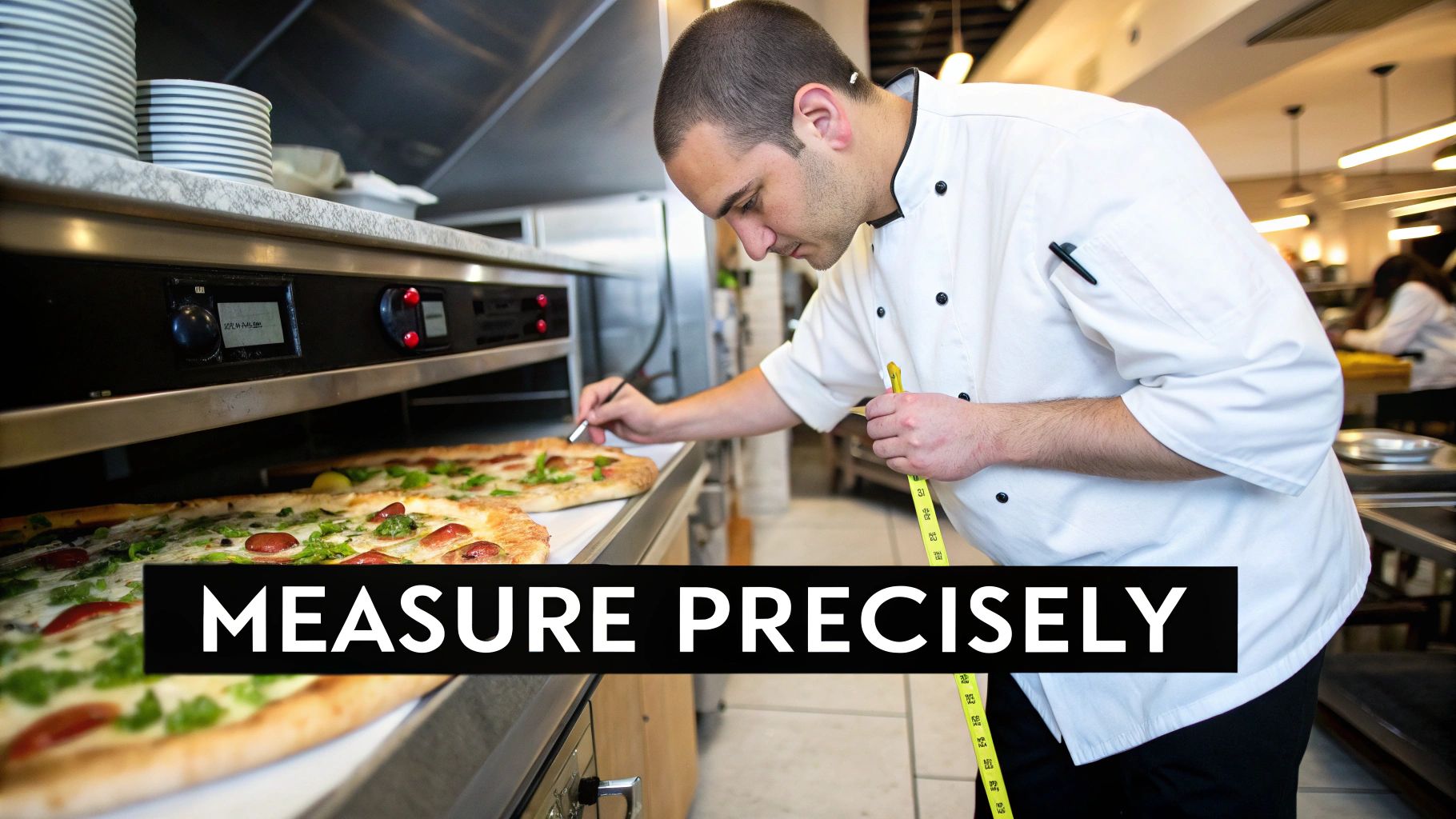
It’s like bringing a new couch home. You wouldn't just measure the wall where it’s going; you’d measure the doorways, the hallways, and every tight corner on the path to make sure it can actually get into the room. The exact same logic applies here, especially in a busy pizzeria where every single inch counts.
The Essential Measurement Checklist for Pizza Restaurants
Before you even start browsing different pizza prep tables, grab your tape measure and get these numbers down. This simple step can save you from costly mistakes and ensures the under counter refrigerator dimensions on a spec sheet will actually work in your real-world space.
- Width: Measure the opening at the top, middle, and bottom. Always use the smallest number as your maximum width—cabinets are rarely perfectly square.
- Height: Measure from the floor to the underside of your countertop. Check in a few spots, because uneven floors are common, especially in older pizzerias.
- Depth: Measure from the back wall to the front edge of the cabinets next to the opening. This is key to making sure your new fridge doesn’t stick out and create a hazard in a busy walkway.
Don't let the little things derail your installation. Always account for the thickness of baseboards, the exact location of electrical outlets, and any plumbing lines that might be hugging the back wall. These are the details that cause big headaches later.
Accounting for Ghost Dimensions
Beyond the basic box measurements, you have to account for what I call "ghost dimensions." These are the invisible spaces that are easy to forget but are absolutely critical for a safe and functional installation. They determine whether your fridge will run efficiently or burn itself out next to the pizza oven.
First up is ventilation. Most commercial units need at least one to two inches of clearance on the sides and back for proper airflow. If you jam a refrigerator right next to a hot pizza oven, you're forcing its compressor to work overtime. That means higher energy bills and a much shorter lifespan for your new unit.
Next, you need to map out the door swing. A refrigerator door that opens into a busy walkway is a workflow killer and a constant safety hazard. Make sure there’s enough clearance for the doors to swing open completely without blocking staff or banging into other equipment. And finally, walk the delivery path from your front door to the kitchen, making sure the unit can actually navigate every turn and doorway to get to its final home.
Critical Factors Beyond Basic Measurements for Pizza Prep Tables
Once you’ve confirmed a unit will physically fit, the real work begins. Will it actually make your pizzeria run smoother? Getting the right under counter refrigerator dimensions is just step one. True kitchen efficiency comes from the little details that separate a good-enough appliance from a great one for a pizza prep line.
Think of this as choosing a partner for your pizza station, not just a box that keeps things cold. The details matter, especially when the dinner rush hits. This is where you graduate from simple measurements to strategic equipment selection.
Compressor Placement and Kitchen Airflow
One of the first big decisions is whether to go with a side-mount or rear-mount compressor. A side-mount compressor is often a technician's best friend—it's way easier to access for maintenance, which can save you a bundle on service calls. On the other hand, a rear-mount compressor can be a lifesaver in tight kitchens where you just don't have the side clearance.
This choice has a huge impact on airflow and how long your unit will last, especially when it's sitting next to a hot pizza oven. A compressor that can't breathe has to work overtime to stay cool, leading to sky-high energy bills and a much shorter lifespan.
The decision isn't just about maintenance; it's about how the refrigerator breathes in a hot, demanding pizzeria. Proper airflow is the difference between a unit that lasts for a decade and one that burns out in a few years.
Doors vs. Drawers for Pizza Ingredients
Next up is the classic debate for pizza prep tables: doors or drawers? This choice directly affects how fast your team can move when orders are flying in.
- Doors: These are your best bet for bulky items. Think large dough trays, buckets of sauce, or backup containers of cheese. They offer maximum flexibility for anything oversized.
- Drawers: When it comes to high-use, pre-portioned toppings like pepperoni, mushrooms, and onions, drawers are king. They give your pizza makers instant, organized access so they can grab what they need without bending over or digging around.
This isn't just a local preference; it's a global one. Commercial kitchens everywhere, especially in high-volume settings, gravitate toward models with flexible storage that can adapt to different prep styles. To get a sense of how these choices influence the bigger picture, you can learn more about commercial undercounter refrigeration trends.
For a deeper dive into making the most of your unit’s storage space, check out our guide on under-counter freezer capacity; many of the same principles apply to refrigerators. And remember, spending a bit more on a higher grade of stainless steel or an ENERGY STAR rating isn't an expense—it's a long-term investment in durability and lower utility bills.
Integrating Your Fridge with a Pizza Prep Table
The best pizza prep lines aren't just a collection of appliances; they're a single, cohesive system firing on all cylinders. Making sure your under-counter refrigerator and the prep table above it work in perfect harmony is one of the most important steps in designing an efficient pizzeria.
Really, the choice between a standalone fridge and a fully integrated prep table boils down to workflow.
An integrated unit is built for speed. The refrigerated prep rail on top—holding your cheese, pepperoni, and veggies—is perfectly lined up with the bulk storage below. This creates an ergonomic, no-reach workflow where every movement is intentional. Your pizza maker can grab a dough ball from the fridge and top the pie without taking a single extra step. For a complete rundown of your options, you can explore a detailed guide to commercial pizza prep tables.
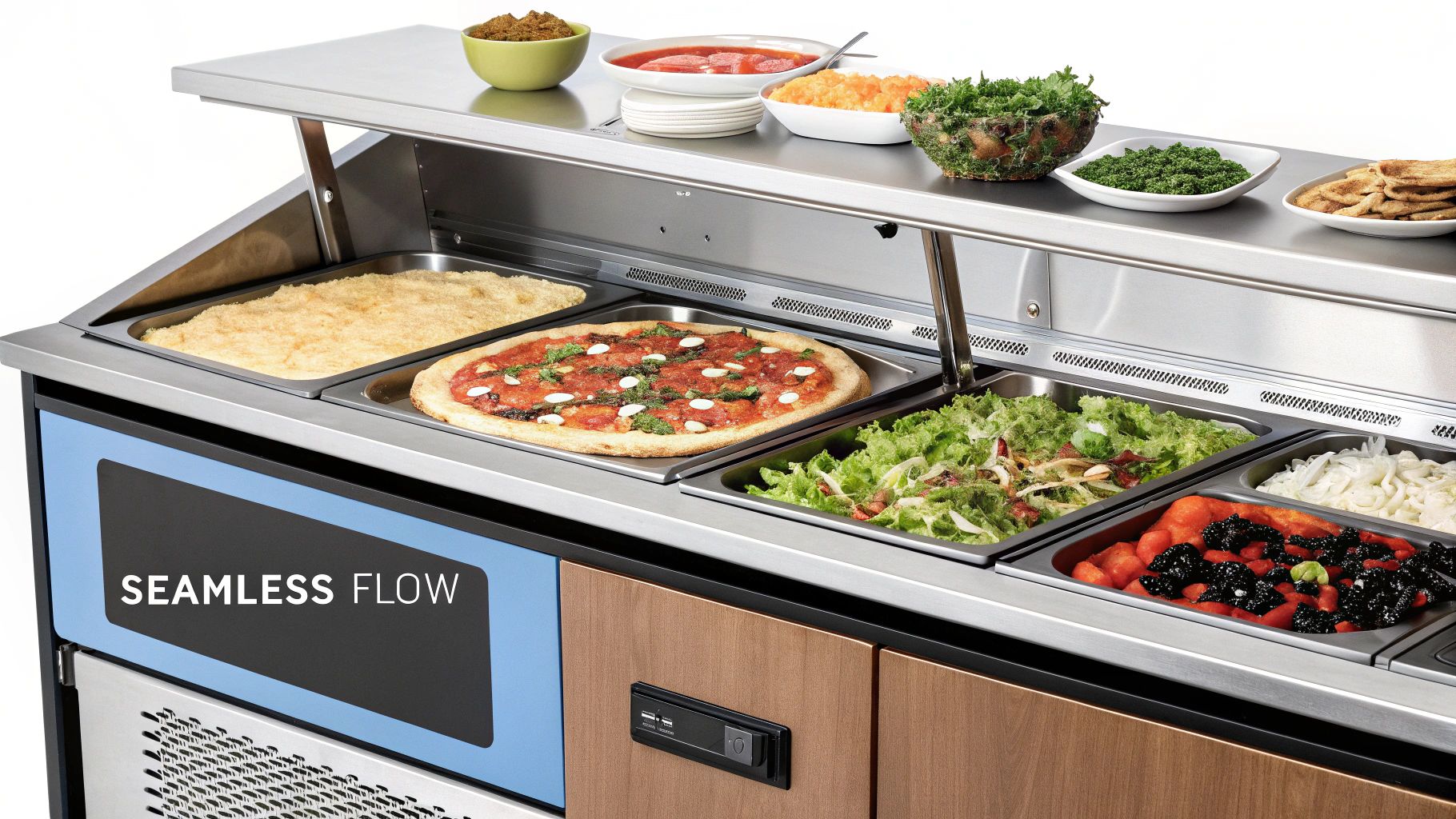
Optimizing Your Pizza Workstation
Beyond just the refrigerator, the materials and overall height of your prep station play a huge role in your team's performance. The countertop material, for instance, directly impacts how well your pizza dough handles.
- Classic Marble: A favorite for its naturally cool surface, marble is fantastic for keeping dough from sticking and is a breeze to clean.
- Durable Stainless Steel: This is the industry standard for a reason. It's incredibly tough, non-porous, and stands up to the heavy wear and tear of a busy pizzeria.
The ultimate goal is to build a station where every task flows seamlessly into the next. The right under counter refrigerator dimensions integrated with a well-designed prep table can slash ticket times and reduce staff fatigue during long, demanding shifts.
The total height of the unit also affects your team's comfort and stamina. A prep surface that’s too high or too low leads to back strain and slower performance. The perfect setup minimizes every unnecessary motion, making the entire pizza-making process smoother and faster.
Common Questions About Pizza Prep Refrigerators
When you’re trying to find the perfect under-counter unit for a pizzeria, a few specific questions always pop up—things that go way beyond just the basic measurements. Getting these details right is what separates a smooth-running kitchen from a chaotic one, ensuring your new pizza prep table helps your workflow instead of getting in the way.
Let's tackle the big ones.
First, pizzeria owners always want to know if drawers are really worth the extra cash. For a high-volume pizza line, the answer is a huge yes. Doors are great for bulky items like dough trays, but drawers give you instant, organized access to your most-used toppings like cheese and pepperoni. That setup can shave precious seconds off every order, which adds up fast during a dinner rush.
Clearance and Steel Grade Considerations
Another question I hear all the time is about clearance space. For any commercial refrigerator—especially one that’s going to live next to a hot pizza oven—proper ventilation isn't just a suggestion, it's a must.
You need to leave a minimum of one to two inches of breathing room on the sides and back. If you don't, you're forcing the compressor to fight for air in a hot, cramped space. That leads to higher energy bills and a much, much shorter lifespan for your equipment.
Finally, how do you pick between different grades of stainless steel? Most pizza prep tables are either 304 or 430-grade.
- 304 Grade: This is the top-of-the-line option. It has superior resistance to corrosion, which makes it perfect for humid kitchens or for anything that comes into contact with acidic ingredients like tomato sauce.
- 430 Grade: This is a more budget-friendly choice. It’s still plenty durable, but it’s more likely to show rust over time if you don’t stay on top of maintenance.
Nailing these details ensures your under counter refrigerator dimensions are backed up by features that can actually handle the heat of a real pizza kitchen.
Ready to build the perfect pizza prep line? Explore our complete selection of high-quality, durable refrigerated prep tables at Pizza Prep Table. Find the ideal dimensions and features to streamline your kitchen’s workflow today at https://pizzapreptable.com.
